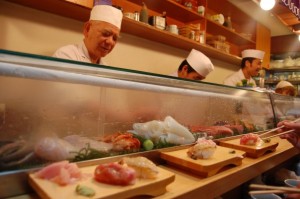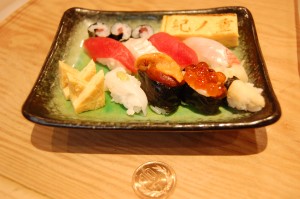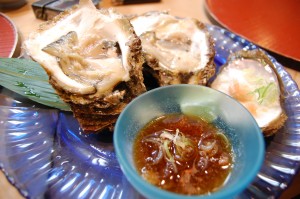The Sushi Experience
 Pushing the noren curtain aside and sliding the wooden doors, you step into a whole new world that you cannot imagine from the indiscernible entrance: the sushi bar. There is an old, tough looking man behind the counter, with his wife as the only staff member. There is no menu except for the kanji written on wooden blocks. We chose this place precisely for the obscurity and authenticity and braced ourselves for real sushi one of our first nights in Japan. The couple speaks no English, and our Japanese at this time is meager at best. All the sushi chef does is make some sort of incomprehensible hand gesture and we nod slowly and anticipate what he makes behind the counter. Suddenly he whips out a net and removes a wildly flapping fish from the tank. His hands move busily and silently, but we cannot see what he is doing from the angle of our tatami mat table. He comes out with a fish, whose intact boney frame is skewered into a U-curve, with its tail and head pointing up, its glassy eyes staring back at us, and its flesh now resting on beds of rice.
Pushing the noren curtain aside and sliding the wooden doors, you step into a whole new world that you cannot imagine from the indiscernible entrance: the sushi bar. There is an old, tough looking man behind the counter, with his wife as the only staff member. There is no menu except for the kanji written on wooden blocks. We chose this place precisely for the obscurity and authenticity and braced ourselves for real sushi one of our first nights in Japan. The couple speaks no English, and our Japanese at this time is meager at best. All the sushi chef does is make some sort of incomprehensible hand gesture and we nod slowly and anticipate what he makes behind the counter. Suddenly he whips out a net and removes a wildly flapping fish from the tank. His hands move busily and silently, but we cannot see what he is doing from the angle of our tatami mat table. He comes out with a fish, whose intact boney frame is skewered into a U-curve, with its tail and head pointing up, its glassy eyes staring back at us, and its flesh now resting on beds of rice.
We didn’t expect it at the time but we had a surprisingly memorable experience trying ikezukuri for the first time. It was a great start to the many sushi bar adventures I would have.
Without a doubt, sushi is my number one food love, with its freshness and accessibility some of the many reasons I love living in Japan. Sushi has been growing in popularity throughout the world. While sushi booms in the West include many fusion inside-out rolls heavily doused in various sauces that would appall the Japanese, they do their job in easing the first timer into the world of sushi. And if enticed enough, the first timer will venture to explore what real sushi is all about; eventually getting into the slimy, cool, raw texture of traditional nigiri and sashimi. Many gaijin do come to Japan to enjoy authentic sushi, from the freshest fish markets like Tsukiji to the fun kurkuru sushi trains.
 While my personal sushi choices tend to favor shiromi (white flesh fish) or hikarimono (silver/shiny skinned fish), living in Japan offers the unique opportunity to try rare fish that is hard to find (or hard on the wallet) in the West. This can be from dangerously exciting fugu (blowfish), the raw shellfish sazae (conch) and awabi (abalone), to crunchy textured namako (sea cucumber). What is also fun is the chance to try delicacies even mezurashii (rare) for the Japanese, like suppon (turtle). We are also lucky that we get to compare both saltier tasting Edo style shari (sushi rice) with Kansai’s sweeter tasting shari.
While my personal sushi choices tend to favor shiromi (white flesh fish) or hikarimono (silver/shiny skinned fish), living in Japan offers the unique opportunity to try rare fish that is hard to find (or hard on the wallet) in the West. This can be from dangerously exciting fugu (blowfish), the raw shellfish sazae (conch) and awabi (abalone), to crunchy textured namako (sea cucumber). What is also fun is the chance to try delicacies even mezurashii (rare) for the Japanese, like suppon (turtle). We are also lucky that we get to compare both saltier tasting Edo style shari (sushi rice) with Kansai’s sweeter tasting shari.
But aside from the taste and texture of the best, freshest sushi, what I love and look for is the experience. And for me the experience literally lies in the hands of the sushi chef.
I have navigated the narrow alleys of Tsukiji market and waited over an hour in line, I’ve driven winding narrow roads to the Japanese sea, to coastal fish markets in inaka towns and to islands like Awaji just to eat the freshest, best fish. Nevertheless I will take an 8 seat sushi bar in a windowless narrow old space, with an aged sushi master and his wife behind a cramped wooden counter, over a popular modern, slick and sexy sushi bar manned with several chefs any day. Both can serve a good quality of sushi, and even if the modern bar serves higher grades of sushi, it is incomparable to what you can get with the intimacy of a one-on-one sushi experience.
When I say “experience,†you can liken it to a show: You may or may not wait in line, the curtains are opened and you hear the genki deep shouts of “Irasshaimasei†and “Dozo!†as you walk in and are seated front row. You stare in awe at the performance of how fast their hands form the nigiri. Teishokus and sushi sets are reasonably priced, but nothing is better than directly ordering from the man who makes your food right in front of your eyes. You are seated in front of someone I can best compare to a magician. How someone can cut your selected netta (actual fish topping), take the shari, and use their fingers to form a perfectly pressed bed of rice in less than 30 seconds is nothing short of magical, like pulling a rabbit out of a hat.
 However what sets apart sushi masters is the attention to detail. The deliciousness of the sushi is equal to how much care the master puts into it.  Like a long-time bartender, he learns what fish you like best, and knows what he can recommend to you. He can cater to you if you prefer smaller shari size. His style of cutting the piece of sushi, how he recommends serving it, if he offers tataki or grilled style, whether he serves you raw octopus with salt, or squeezes lemon on your uni or ika. These little details make the sushi experience more enjoyable and more delicious. And like a bartender, if you can crack that tough exterior, you can enjoy the chit chat depending on the atmosphere. If the chef cares about the food and your experience, he will tell you more about what fish you are eating, where it comes from, information about how its caught, when it’s best in season and why. You really learn about the food you are eating. Not to mention there is that intimacy of having your own personal chef. From your words to their fingers and their blade of steel to your plate, you sense you are being treated special and the food is special.  The attention given to the customer and the sushi makes you come back for more. It’s easy for us gaijin to feel intimidated to slide open the door and be put yourself at the mercy of old Japanese men, but these small, long-standing sushi bars are gems worth seeking out. So take advantage of your time in Japan: push back that noren, step inside and ready yourself for the delicious adventure of the sushi bar experience.
However what sets apart sushi masters is the attention to detail. The deliciousness of the sushi is equal to how much care the master puts into it.  Like a long-time bartender, he learns what fish you like best, and knows what he can recommend to you. He can cater to you if you prefer smaller shari size. His style of cutting the piece of sushi, how he recommends serving it, if he offers tataki or grilled style, whether he serves you raw octopus with salt, or squeezes lemon on your uni or ika. These little details make the sushi experience more enjoyable and more delicious. And like a bartender, if you can crack that tough exterior, you can enjoy the chit chat depending on the atmosphere. If the chef cares about the food and your experience, he will tell you more about what fish you are eating, where it comes from, information about how its caught, when it’s best in season and why. You really learn about the food you are eating. Not to mention there is that intimacy of having your own personal chef. From your words to their fingers and their blade of steel to your plate, you sense you are being treated special and the food is special.  The attention given to the customer and the sushi makes you come back for more. It’s easy for us gaijin to feel intimidated to slide open the door and be put yourself at the mercy of old Japanese men, but these small, long-standing sushi bars are gems worth seeking out. So take advantage of your time in Japan: push back that noren, step inside and ready yourself for the delicious adventure of the sushi bar experience.







I also enjoy the intimacy of smaller sushi shops especially the explanations of each fish. In a not-so-unrelated topic, are you worried about the affect the Fukushima circumstances are having on your precious fish intake? I am a little concerned, and for Japan as a nation as well (considering their reliance on marine life).